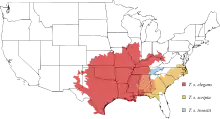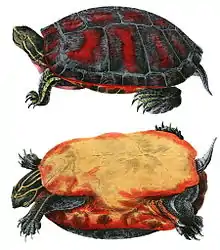Pond slider
The pond slider (Trachemys scripta) is a species of common, medium-sized, semiaquatic turtle. Three subspecies are described,[2] the most recognizable of which is the red-eared slider (T. s. elegans), which is popular in the pet trade and has been introduced to other parts of the world by people releasing it to the wild. Hatchling and juvenile pond sliders have a greenish upper shell (carapace), yellow bottom shell (plastron), and green and yellow stripes and markings on their skin. These patterns and colors in the skin and shell fade with age until the carapace is a muted olive green to orange brown or brown and the plastron is a dull yellow or darker. Some sliders become almost black with few visible markings. The carapace is oval with a bit of rounding and a central crest with knobs, but these features soften and fade with age, adults being smoother and flatter. For determining an adult slider's sex, males typically have much longer front claws than adult females, while females usually have shorter, more slender tails than males. Their lifespans range from 20–50 years.
| Pond slider | |
|---|---|
 | |
| Trachemys scripta elegans, the red-eared slider | |
| Scientific classification | |
| Kingdom: | Animalia |
| Phylum: | Chordata |
| Class: | Reptilia |
| Order: | Testudines |
| Suborder: | Cryptodira |
| Superfamily: | Testudinoidea |
| Family: | Emydidae |
| Genus: | Trachemys |
| Species: | T. scripta |
| Binomial name | |
| Trachemys scripta | |
 | |
| Subspecies range map in the United States. Red: red-eared slider (also in Mexico) Yellow: yellow-bellied slider Blue: Cumberland slider | |
Etymology
The origin of the name slider stems from the behavior of these turtles when startled. Groups of sliders, sometimes quite large, as well as many other types of less abundant freshwater turtles, are often seen basking and sunning on logs, branches, and vegetation at or even well above the water's surface, but they readily and quickly scramble if they sense danger, shooting back in and darting away to safety underwater.
Distribution
Pond sliders are native to the south-central and southeastern United States and northern Mexico.
Invasive species
In the 1900s, many pond sliders were captured for sale. In the 1950s, millions of turtles were being farmed and shipped abroad as part of pet trade.
These turtles often compete with native species for food, habitats, and other resources. Eventually, they bully many native species out of basking sites, where sunlight (and warmth) is available for the species. When basking, pond sliders commonly bask on birds nests, thereby killing the eggs. They also prey on young birds.
Turtles that were raised in captivity can develop diseases that are unfamiliar to native species, which can be harmful. Turtles raised in captivity are often released because they become too much to handle or grow bigger than expected. Not uncommonly, they also escape.
Conservationists have warned owners of turtles to not release them into the wild. Many states also have passed legislation to control the possession and release of pond sliders. Two states have completely banned the sale of these turtles.
Subspecies

- T. s. scripta – yellow-bellied slider[2]
- T. s. elegans – red-eared slider[2]
- T. s. troostii – Cumberland slider[2]
Hybridization between yellow-bellied and red-eared sliders is not uncommon where the ranges of the two subspecies overlap.[5]
References
- van Dijk, P.P.; Harding, J. & Hammerson, G.A. (2011). "Trachemys scripta". IUCN Red List of Threatened Species. 2011: e.T22028A97429935. doi:10.2305/IUCN.UK.2011-1.RLTS.T22028A9347395.en.{{cite iucn}}: error: |doi= / |page= mismatch (help)
- Rhodin, Anders G.J.; van Dijk, Peter Paul; Inverson, John B.; Shaffer, H. Bradley (2010-12-14). "Turtles of the World 2010 Update: Annotated Checklist of Taxonomy, Synonymy, Distribution and Conservation Status" (PDF). Archived from the original (PDF) on 2010-12-15. Retrieved 2010-12-15.
- First described by Carl Peter Thunberg, and published in:
Ioannis Davidis Schoepff (1792). Historia Testudinum Iconibus Illustrata. Published in Erlangen, by Ioannis Iacobi Palm. p. 16-17. - Fritz 2007, pp. 207-208
- Trachemys scripta elegans × Trachemys scripta scripta Project Noah
Further reading
- Fritz, Uwe; Havaš, Peter (2007-10-31). "Checklist of Chelonians of The World" (PDF). Archived from the original (PDF) on 2010-12-29. Retrieved 2010-12-29.
- "Invasive Species Initiative". InvasiveSpeciesInitiative.com. Jenny Burger. Retrieved 25 March 2018.
- "Habitat Attitude". Habitatattitude.net. Retrieved 27 March 2018.
External links
- J. Servan et C. Arvy, "The introduction of Trachemys scripta in France. A new competitor for the European pond turtles". Bull. Fr. Pêche Piscic. Number 344-345, 1997
- Dewey, T. and T. Kuhrt. (2002). "Trachemys scripta" (On-line), Animal Diversity Web. Accessed July 29, 2008 at http://animaldiversity.ummz.umich.edu/site/accounts/information/Trachemys_scripta.html.
- Rhudy, Robyn "Sliders" (On-Line), Accessed April 29, 2009. at http://www.fishpondinfo.com/turtles/sliders.htm
| Wikispecies has information related to Trachemys scripta. |

